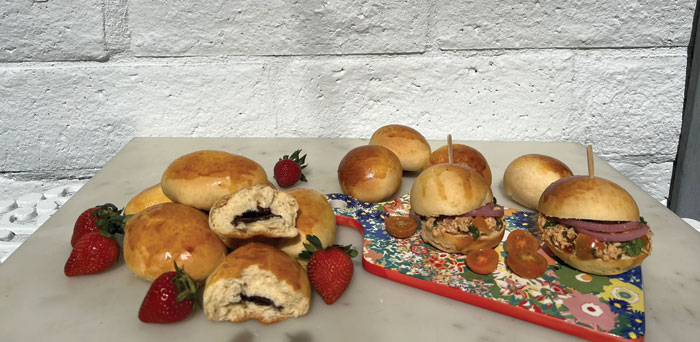
It’s 1970, it’s somebody’s birthday and life is beautiful in Casablanca.
We are in the backyard of my aunt Clara and uncle Menasse. The men play cards and the women chat casually, sitting in the sun with their stylish shift dresses and glamorous teased hairstyles.
My brothers and my cousins Alia, Simy and Rachel are blasting Johnny Hallyday records and reading Asterix comic books. My cousin Felix and I run around, laughing and singing. At one point, we even try to ride his German Shepherd.
There’s mint tea and Orangina soda. There are bollitos, little bread rolls, filled with tuna and fresh vegetables and petit pain au chocolat, little rolls filled with melted dark chocolate. There are salads and fruit and sweets. But it’s those breads that I loved.
Bread was such an integral part of my Jewish Moroccan heritage. I was taught that whenever bread falls to the ground, to quickly pick it up and kiss it.
Bread was such an integral part of my Jewish Moroccan heritage. I was taught that whenever bread falls to the ground, to quickly pick it up and kiss it. I’ve been doing this all my life, without a second thought. My parents ingrained in me that bread is a blessing from Heaven, symbolic of health, wealth and sustenance.
The Moroccan Jews surely loved their bread. Their home baked bread was made with such simple, wholesome ingredients and no storebought bread can ever compare. Our grandmothers had quality control over what they were serving their families—the wheat was locally grown and they would grind it into flour themselves. Most households would mix and knead the ingredients for bread early, every morning. Then it would be sent to the community oven to bake. The bread was a simple round flat bread called khob’z. Shabbat and festive holiday breads were more elaborate, usually flavored with anise seed and beautifully shaped and decorated.
The breads were carried on large trays or wooden planks and carried to the community ovens by the maids or the children. Each household had a distinguishing mark on their tray to ensure they received their own bread after baking.
In Morocco and North Africa in general, ovens were not so important. Most homes, even wealthy homes, didn’t have ovens. While Western cuisine emphasizes roasting and baking, Maghrebi cooking is mostly done on a stove top, with tagines over a fire.
The communal oven was shared by the entire neighborhood and was used to bake bread, cakes and cookies. Even families who did have an oven at home preferred to send things to the communal oven. The wood fired ovens reached a much higher temperature than a household oven and the wood smoke imparted a much nicer taste to the bread. Not to mention that on hot summer days it made much more sense to send the bread out to bake, rather than creating more heat in the home.
We were spoiled in eating home baked bread. When we did buy baguette or a loaf of sandwich bread, it was freshly baked by a local bakery. There were no preservatives or fillers in the bread that we ate.
The most iconic of the baked bread treats that I enjoyed as a child were these slightly sweet, fluffy, heavenly little bread rolls. In Spanish, they were called Bollitos and in French, Petit Pain. My mother and aunt would bake these for birthdays or holidays, for afternoon snacks or to serve at tea time. Some were plain rolls that we ate with butter and jam or stuffed with tuna or egg salad. My favorite way to eat them was with butter and shredded Swiss cheese. The ultimate treat was petit pain au chocolat. A few squares of chocolate were placed inside the dough before baking. When eaten warm, the chocolate was all melted and incredible. Regrettably, I never wrote down my mother’s recipe, but recently my cousin Raymonde Barishman mentioned that she had my grandmother’s recipe, along with a few others that were passed down by our Israeli cousins. I was overjoyed knowing I could make these just like my grandmother and my mother. Food memories bring me back to Morocco. I don’t remember a lot as I left at the age of 8. But certain foods bring me back. When I bite into a petit pain au chocolat or bollito, the memories come easily.
—Rachel
Bread is integral to Jewish culture. We recite the blessing Ha’Motzi Lechem Min Ha”Aretz before meals and there’s no Shabbat without challah.
This delicious bread recipe is just perfect for right now.
—Sharon
Bollitos Recipe
7-8 cups flour
4 large eggs, with one yolk set aside
1 cup sugar
1 cup oil
2 teaspoons yeast, dissolved in one cup of lukewarm water
½ cup milk (optional, can substitute almond milk or orange juice)
In a small bowl, mix yeast and water;let stand for 5 minutes.
In a large bowl or stand mixer, combine all the ingredients, starting with 7 cups of flour. Add more flour if the dough is too sticky to handle.
If using a mixer, dough is ready when it comes together and releases from the sides of the mixer bowl.
Place dough in a large greased bowl. Cover the dough and let rest one hour.
Roll the dough into golf ball size balls, or tennis ball size if you want to fill for small sandwiches.
To make petit pain au chocolat, stretch the dough into a rectangle shape and flatten with the palm of the hand, place a few chocolate squares in the middle, then fold sides over and pinch to close.
Brush with the egg yolk.
Sprinkle with sugar (optional).
Bake for 20 to 25 minutes at 350°F.
Makes 3 – 4 dozen rolls.
Rachel Sheff and Sharon Gomperts have been friends since high school. They love cooking and sharing recipes. They have collaborated on Sephardic Educational Center projects and community cooking classes. Follow them on Instagram @sephardicspicegirls and on Facebook at Sephardic Spice SEC Food.






















 More news and opinions than at a Shabbat dinner, right in your inbox.
More news and opinions than at a Shabbat dinner, right in your inbox.